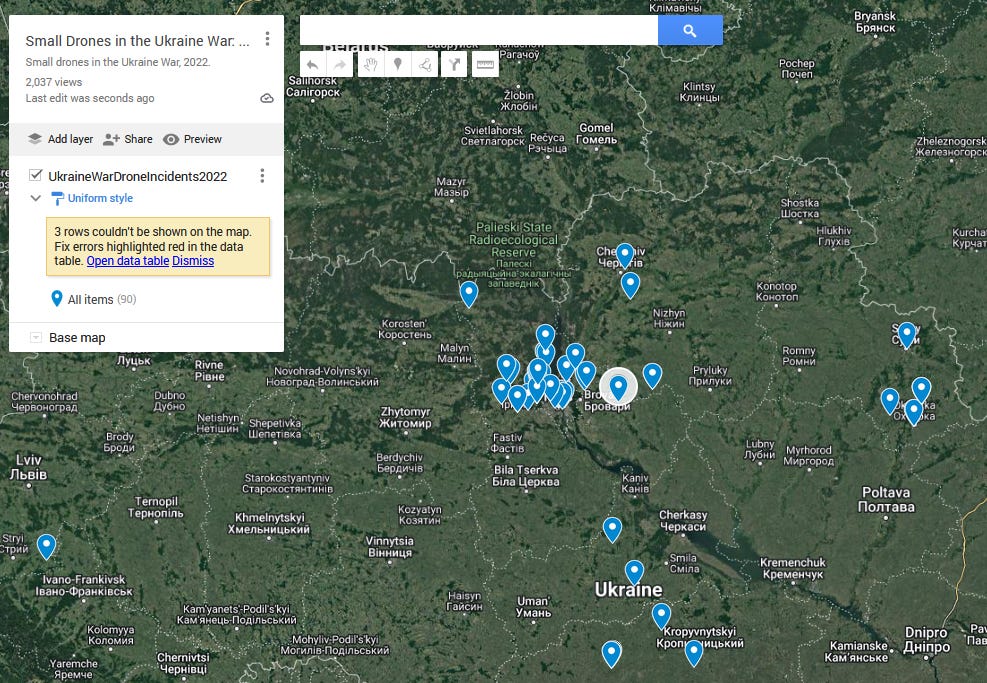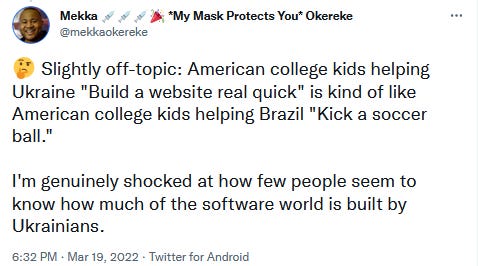Ukraine is Using Drone Video to Win the Information War
And other thoughts on how consumer drones are factoring into the war in Ukraine
Since Russian tanks began to rumble into Ukraine on February 24th, I’ve been keeping an eye on the sky. Specifically, I’ve been keeping track of how commercial drones are factoring into the ongoing conflict, in a spreadsheet and map that I update as often as I can.

While small and inexpensive drones have been popping up on battlefields around the world ever since the commercial drone boom really kicked off in the early 2010s, I’ve never seen anything like this before.
Here’s a few of my thoughts, based on what I’ve witnessed from the war so far. This will be the first post in an ongoing series.
Ukraine Has Been Using Drones for A Long Time
Ukraine’s history with small drones goes way further back than 2022.
When the Euromaidan protests against then-president Viktor Yanukovych began in November 2013, Ukrainian journalists and activists were some of the first people to start using home-built and commercial drones to document the sheer scale of the public outcry.
I remember those videos from Kyiv clearly, because that fall marked the beginning of my own interest in drones. I spent hours perusing that footage, wondering if that was what the future would be like.
And then, in early 2014 - just days after the Olympics, in a rather eerie parallel to the 2022 war - Putin invaded Crimea, and vicious fighting driven by Russia-backed separatist groups kicked off in the Donbas border region.
Drone pilots were there, too. After the shooting stopped at the Donestk Airport, a fundraising collective for the Ukrainian army called Army SOS published a drone video of the ruined airport. The footage made headlines around the world, both for its novelty and because of how clearly it showed the immense damage
Then, American drone journalism expert Matthew Schroyer used photogrammetry software to construct a detailed 3D model of the ruins, one of the first instances I can remember of journalists using drones remarkable reality-scanning abilities to tell a story. (Twitter user @stim3on recently used a similar tactic to represent destruction in Borodyanka).
Ukrainians also swiftly began to learn how to use drones for war.
Ukraine is an exceedingly tech-savvy country. As @mekkaokereke pointed out on Twitter, in reference to that ill-conceived and insecure refugee housing website a couple Harvard kids put together recently with far too much fanfare:

In 2013 and 2014, the DIY drone hobby scene that I was part of in the San Francisco Bay Area was expanding globally at a rapid clip. By the time Putin invaded, Ukraine was already home to people who knew damn well how to turn an assemblage of electronic bits ordered from eBay into a functional drone. It was also home to a well-known aeronautics industry. And yet, at the time, the Ukrainian army didn’t have any modern UAVs at all.
They caught up quickly, as many excellent news stories from that time period between now and then reported.
Hobbyists joined forces with the military to figure out how to build better drones. Ukrainians also made use of cheap commercial platforms that they could simply purchase and then modify as they saw fit, especially those made by China’s DJI company. Crucially, they figured out how to better convey drone-collected data to the Ukrainian General Staff so that they could make decisions with it (an utterly essential step that far too many drone-using organizations ignore).
Soon enough, Ukraine’s military had developed formidable drone capacities, spanning the gamut from the now famous Turkish-made Baryaktar 2 drones to locally-produced medium sized surveillance drones to inexpensive DJI products. They used those drones to spy on separatist and Russian positions, to spot targets for later air strikes, and even customized them to drop grenades into their trenches (forcing separatists to cover their trenches with netting).
In one incredible video from 2021, shot in the Donbas border region, a Ukrainian pilot flies what appears to be a hobby-built and screamingly fast racing drone right over the heads of some incredibly-surprised looking separatists - and captured clear images of the mine-launchers they were using.
All of this explains why Ukraine was ready to wage the most impressive and inexpensive drone war that the world has ever seen.
Witnessing War From the Air
Video from combat is usually messy and chaotic. Usually, the camera-person is somewhere in between scared out of their minds and actively running away - eminently understandable reactions that also don’t tend to generate the most stable and clear footage.
Drones have changed that. We’ve never seen video from war like this before. (Warning: the following videos are graphic).
I keep thinking about an instance a few weeks ago where, as German news outlet ZDF reported, a Ukrainian soldier (who’d been a businessman just weeks before) was keeping overwatch on a highway near Kyiv with his DJI Mavic. With the drone serving as a mechanical middleman, the pilot observed a Russian tank nearby the roadway, with armed Russian soldiers in the vicinity.
Two civilian cars approaching the tank appear to notice its presence and, entirely rationally, attempt to turn around. One car escapes: the driver of the other car stops next to the remains of another shot-up civilian car and gets out with his hands in the air. Almost immediately, the Russians shoot him. More Russians approach and spirit the man’s wife and child off into the woods, to an unknown fate. The drone camera, hundreds of feet up in the air, quietly recorded the entire horrific incident in 4K.
I also think of a video released by the Ukrainian armed forces earlier in March, where footage shot by what appears to be a commercial drone shows a Ukrainian missile smashing into a Russian helicopter in mid-flight. The drone, hovering at almost the exact same altitude as the helicopter, captures video so clear that you can clearly see the missile itself before impact. It’s a perspective that would have been impossible to capture in any other way.
It’s just one of dozens and dozens of similarly remarkable drone videos of active combat that have come out of the war, documenting horrific violence in a completely novel way. I don’t know exactly what that means, not now, anyway, but I know it’s meaningful.
Which brings me to another topic: how the Ukrainian armed forces are using drone video.
Winning The Information War With Drone Video
Ukraine is, unexpectedly, completely trouncing Russia in the information war that’s currently raging on social media and on TV networks around the globe. Drone video, released and officially endorsed by Ukrainian sources, has been a key part of that strategy.
The main reason we’re seeing so many incredible drone videos of the war is because Ukraine really wants us to be seeing them. Ukrainians figured that out back in 2014, when that video of the Donestk airport I mentioned above made headlines around the world. And it’s a brilliant strategy.
In a recent address to Congress, President Zelensky presented an exceptionally well-done and graphic video documenting the suffering and violence that Russia has subjected Ukrainian civilians to - a video that included a few drone-collected shots of locations in the country before the war began, to set the stage. Various wings of the Ukrainian Armed Forces regularly release drone video of the fighting to official Facebook and Telegram pages, videos which are then immediately snapped up and shared around the world.
Russia, meanwhile, has released very few drone videos in general, and has released almost none that appear to be shot by commercial drones equipped with high-quality cameras. (Generally speaking, Russia appears to be using both military and commercial drones much less extensively than most assumed they would).
While we do know that at least some Russian troops are using small drones like the DJI Mavic, Russia largely hasn’t been sharing those videos with the world. The few exceptions that do exist, like this drone video that Russians tried to use to justify attacks on residential buildings, haven’t gained nearly as much traction as the Ukrainian footage. That means that Ukraine has been able to almost completely dominate the documentation of this war from the air, which is a very powerful thing indeed.
Journalists are also relying heavily on drone video to convey the sheer scale of the destruction in Ukraine to the world. News reports regularly feature drone-collected video floating dreamily over bombed out Ukrainian cities and towns, conveying a sense of scale. In many cases, journalists have been using drones to check up on areas that are extremely dangerous to access, like the now-infamous Irpin bridge, where multiple people - including a journalist - have been killed by Russian attacks in recent weeks.
Some of the drone videos I’ve seen in recent weeks lack a clear source or origin. As Ukraine certainly had a robust drone-owning community before hostilities began, I suspect that at least some of these videos have been shot by people who are neither journalists or soldiers. It’s easy to imagine how someone subjected to shelling who has a drone on hand might want to use it to get a sense of what the hell is going on. If I were them, I know I would.
As you’ve probably inferred, many different actors - soldiers, journalists, civilians - are using pretty much identical commercial drones in the exact same places during this war. Consider the case of the Irpin bridge, where Ukrainian soldiers were shooting at a drone they believed was Russian one day (see the video above), while a BBC journalist flew their drone in the exact same location just a few days afterwards.
I worry that this will inevitably lead to cases of mistaken identity and issues under international humanitarian law, something I’ve written about recently for the ICRC. Drones aren’t going anywhere in conflict, and we need to figure out where they stand, and what we should be advising the people who use them to do.
More posts on drones and the war in Ukraine to follow.
